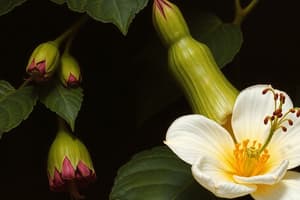Podcast
Questions and Answers
What is the primary function of the stigma in the pollination process?
What is the primary function of the stigma in the pollination process?
- To divide and form a zygote
- To receive pollen grains from the anther (correct)
- To transport sperm cells to the egg cell
- To produce pollen grains
What is the term for the process of transferring pollen from the male reproductive organ to the female reproductive organ?
What is the term for the process of transferring pollen from the male reproductive organ to the female reproductive organ?
- Embryogenesis
- Fertilization
- Gametophyte development
- Pollination (correct)
What is the result of the fusion of a sperm cell with the egg cell during fertilization?
What is the result of the fusion of a sperm cell with the egg cell during fertilization?
- Formation of the zygote (correct)
- Formation of the proembryo
- Formation of the megagametophyte
- Formation of the endosperm
What is the term for the haploid generation in the life cycle of flowering plants?
What is the term for the haploid generation in the life cycle of flowering plants?
During fertilization, what is the function of the pollen tube?
During fertilization, what is the function of the pollen tube?
What is the first stage of embryogenesis in flowering plants?
What is the first stage of embryogenesis in flowering plants?
Study Notes
Sexual Reproduction in Flowering Plants
Pollination
- The process of transferring pollen from the male reproductive organ (anther) to the female reproductive organ (stigma)
- Types of pollination:
- Self-pollination: within the same flower or plant
- Cross-pollination: between different flowers or plants
- Agents of pollination:
- Biotic: insects (bees, butterflies, moths), birds, bats, and other animals
- Abiotic: wind, water
Fertilization
- The fusion of male and female gametes (sperm and egg cells) to form a zygote
- Process:
- Pollen germination: pollen grain absorbs water and grows a pollen tube
- Pollen tube growth: tube grows down through the style and into the ovary
- Sperm release: two sperm cells are released from the pollen tube
- Fertilization: one sperm cell fuses with the egg cell to form a zygote
- Double fertilization: second sperm cell fuses with the central cell to form the endosperm
Gametophyte Development
- Gametophyte: the haploid (n) generation in the life cycle of flowering plants
- Male gametophyte (microgametophyte):
- Develops from a microspore within the anther
- Produces two sperm cells
- Female gametophyte (megagametophyte):
- Develops from a megaspore within the ovule
- Produces the egg cell and central cell
Embryogenesis
- The process of embryonic development from the zygote
- Stages:
- Zygote division: zygote divides to form a proembryo
- Embryo formation: proembryo develops into a mature embryo
- Organogenesis: embryo develops into a seedling with root, stem, and leaf structures
- Important structures formed during embryogenesis:
- Radicle (primary root)
- Cotyledon (seed leaf)
- Hypocotyl (stem)
Studying That Suits You
Use AI to generate personalized quizzes and flashcards to suit your learning preferences.
Description
Learn about the process of sexual reproduction in flowering plants, including pollination, fertilization, gametophyte development, and embryogenesis. Understand the different types of pollination, agents of pollination, and the stages of embryonic development.



